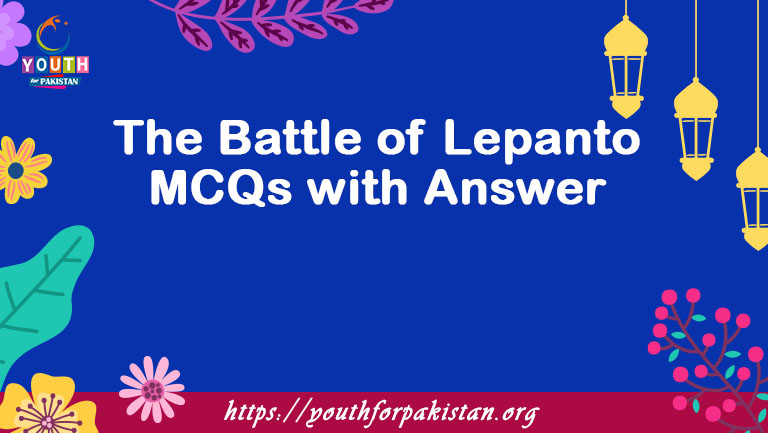The following are The Battle of Lepanto MCQs with answers related to Islamic Studies. We have arranged the most important and repeated MCQs in all the competitive examinations. The students can clear their concepts for The Battle of Lepanto MCQs online quiz by attempting these.
The Battle of Lepanto Online MCQs with Answers
In which year did The Battle of Lepanto take place?
A) 1571
B) 1492
C) 1620
D) 1555
The Battle of Lepanto was a significant naval battle fought between:
A) Ottoman Empire and Venice
B) Ottoman Empire and Spain
C) Ottoman Empire and France
D) Ottoman Empire and England
Who led the Holy League, a coalition of Christian states, during the Battle of Lepanto?
A) Pope Pius V
B) King Philip II of Spain
C) Admiral Andrea Doria
D) Sultan Selim II
The Ottoman fleet at the Battle of Lepanto was commanded by:
A) Suleiman the Magnificent
B) Barbarossa Hayreddin Pasha
C) Mehmed II
D) Osman I
Which sea was the setting for the Battle of Lepanto?
A) Mediterranean Sea
B) Black Sea
C) Red Sea
D) Adriatic Sea
What was the primary motivation for the Holy League in opposing the Ottoman fleet at Lepanto?
A) Territorial expansion
B) Religious conflict
C) Economic rivalry
D) Cultural exchange
Who was the Ottoman Sultan at the time of the Battle of Lepanto?
A) Suleiman the Magnificent
B) Selim II
C) Mehmed II
D) Osman I
What was the outcome of the Battle of Lepanto?
A) Ottoman victory
B) Christian victory
C) Stalemate
D) Truce
Which Christian organization played a significant role in the formation of the Holy League for the Battle of Lepanto?
A) The Knights Templar
B) The Society of Jesus (Jesuits)
C) The Franciscan Order
D) The Knights Hospitaller
What was the primary naval weapon used by both sides in the Battle of Lepanto?
A) Cannons
B) Crossbows
C) Catapults
D) Torpedoes
Which famous poet wrote an epic poem about the Battle of Lepanto, immortalizing the Christian victory?
A) Dante Alighieri
B) Geoffrey Chaucer
C) Miguel de Cervantes
D) Homer
Which significant Ottoman naval commander was killed during the Battle of Lepanto?
A) Suleiman the Magnificent
B) Barbarossa Hayreddin Pasha
C) Mehmed II
D) Osman I
What was the primary objective of the Ottoman Empire in the Battle of Lepanto?
A) To expand its territorial holdings
B) To assert its naval dominance
C) To protect its trade routes
D) To capture the Pope
Which European country provided the largest contingent of ships for the Holy League in the Battle of Lepanto?
A) Spain
B) France
C) England
D) Venice
How did the Battle of Lepanto impact the Ottoman Empire’s naval power?
A) It strengthened Ottoman naval dominance
B) It had no impact on Ottoman naval power
C) It weakened Ottoman naval capabilities
D) It led to the decline of the Ottoman Empire
What role did the weather play in the outcome of the Battle of Lepanto?
A) The weather had no impact on the battle
B) Favorable winds helped the Holy League
C) Strong currents favored the Ottomans
D) A storm disrupted both fleets
Which naval technology gave the Holy League a significant advantage in the Battle of Lepanto?
A) Fire ships
B) Torpedoes
C) Submarines
D) Steam-powered ships
How did the Battle of Lepanto impact the spread of Islam in Europe?
A) It led to the widespread conversion of Europeans to Islam
B) It had no impact on the spread of Islam in Europe
C) It slowed the expansion of Islam in Europe
D) It facilitated the spread of Islam in Europe
What was the role of the Venetian Republic in the Holy League during the Battle of Lepanto?
A) Venice provided most of the troops
B) Venice supplied the Holy League with cannons
C) Venice was the primary financial supporter
D) Venice led the Holy League’s fleet
Which side had a numerical advantage in terms of ships at the Battle of Lepanto?
A) The Holy League
B) The Ottomans
C) Both sides had equal numbers of ships
D) It is unknown
Who was the commander-in-chief of the Holy League fleet at the Battle of Lepanto?
A) Pope Pius V
B) King Philip II of Spain
C) Admiral Andrea Doria
D) Don John of Austria
How did the Battle of Lepanto affect the power and influence of the Ottoman Empire in the Mediterranean?
A) It enhanced Ottoman control of the Mediterranean
B) It had no impact on Ottoman influence in the region
C) It significantly diminished Ottoman influence
D) It resulted in Ottoman withdrawal from the Mediterranean
Which European city served as the headquarters of the Holy League during the Battle of Lepanto?
A) Rome
B) Venice
C) Madrid
D) Paris
What was the primary role of galleys in naval warfare during the Battle of Lepanto?
A) To transport troops
B) To serve as flagships
C) To fire cannons
D) To ram enemy ships
What was the significance of the Battle of Lepanto in the context of the larger struggle between Christianity and Islam?
A) It marked the end of Islamic expansion in Europe
B) It had no impact on the religious struggle
C) It led to the conversion of Ottoman leaders to Christianity
D) It resulted in a lasting Christian-Muslim alliance
Which famous Venetian explorer and trader was present at the Battle of Lepanto?
A) Marco Polo
B) Christopher Columbus
C) Amerigo Vespucci
D) Niccolò de’ Conti
How did the Battle of Lepanto affect the Ottoman Empire’s territorial control in Europe?
A) It resulted in Ottoman expansion in Europe
B) It had no impact on Ottoman territories in Europe
C) It led to the loss of Ottoman-held territories in Europe
D) It established a permanent Ottoman presence in Europe
What was the primary reason for the Holy League’s victory at the Battle of Lepanto?
A) Superior naval tactics
B) More experienced sailors
C) Advanced weaponry
D) Divine intervention
Which religious leader played a significant role in rallying Christian support for the Holy League?
A) Pope Pius V
B) Martin Luther
C) John Calvin
D) Pope Clement VII
Which side had the advantage of surprise during the Battle of Lepanto?
A) The Holy League
B) The Ottomans
C) Both sides were equally surprised
D) It is unknown
Which Ottoman naval commander was captured during the Battle of Lepanto?
A) Suleiman the Magnificent
B) Barbarossa Hayreddin Pasha
C) Mehmed II
D) Osman I
What was the main reason for the Holy League’s formation prior to the Battle of Lepanto?
A) Economic cooperation
B) Cultural exchange
C) Religious unity against the Ottoman threat
D) Political alliance
Which naval technology gave the Ottoman fleet an advantage in maneuverability during the Battle of Lepanto?
A) Larger ships
B) Faster sails
C) Oars
D) Steam engines
Which side had the stronger artillery and cannons during the Battle of Lepanto?
A) The Holy League
B) The Ottomans
C) Both sides had equal firepower
D) It is unknown
What was the primary role of galleasses in the Holy League’s fleet during the Battle of Lepanto?
A) To transport troops
B) To serve as flagships
C) To fire cannons
D) To ram enemy ships
How did the Battle of Lepanto impact the rivalry between the Ottoman Empire and the Habsburg Monarchy?
A) It intensified their rivalry
B) It led to a lasting peace treaty
C) It resulted in a political union
D) It had no lasting impact
Which Ottoman province served as a base for the Ottoman fleet during the Battle of Lepanto?
A) Anatolia
B) Egypt
C) Constantinople (Istanbul)
D) Algiers
What was the primary role of the Papal States in the Holy League during the Battle of Lepanto?
A) To provide military leadership
B) To supply ships
C) To offer financial and moral support
D) To serve as diplomats
Which European country played a central role in providing naval expertise and leadership for the Holy League?
A) Spain
B) France
C) England
D) Portugal
What was the Holy League’s primary objective in defeating the Ottoman fleet at Lepanto?
A) To capture Ottoman territory
B) To secure control of trade routes
C) To prevent Ottoman expansion into Europe
D) To acquire Ottoman technology
How did the Battle of Lepanto affect the morale of Christian Europe?
A) It boosted Christian morale
B) It had no impact on Christian morale
C) It lowered Christian morale
D) It led to religious schisms
Which side suffered higher casualties in terms of both ships and personnel at the Battle of Lepanto?
A) The Holy League
B) The Ottomans
C) Both sides suffered equal casualties
D) It is unknown
Which city served as the headquarters of the Ottoman navy during the Battle of Lepanto?
A) Constantinople (Istanbul)
B) Alexandria
C) Algiers
D) Tripoli
What role did wind patterns play in the strategy of the Holy League during the Battle of Lepanto?
A) The Holy League used wind patterns to set fireships ablaze
B) Wind patterns helped the Holy League navigate the battle
C) The Holy League used wind patterns to signal retreat
D) Wind patterns favored the Ottoman fleet
How did the Battle of Lepanto impact the Ottoman Empire’s territorial control in North Africa?
A) It expanded Ottoman control in North Africa
B) It had no impact on Ottoman territories in North Africa
C) It led to the loss of Ottoman-held territories in North Africa
D) It resulted in a lasting Ottoman presence in North Africa
What was the primary Ottoman strategy in the Battle of Lepanto?
A) To engage in hit-and-run tactics
B) To encircle and capture the Holy League’s flagship
C) To lure the Holy League into a narrow channel
D) To establish a naval blockade
How did the Battle of Lepanto affect the Ottoman Empire’s control of key trade routes?
A) It secured Ottoman control of trade routes
B) It had no impact on trade routes
C) It disrupted Ottoman control of trade routes
D) It resulted in a trade alliance with Europe
Which Ottoman naval tactic was used to board and capture enemy ships during the Battle of Lepanto?
A) Ramming
B) Boarding with grappling hooks
C) Firing cannons from a distance
D) Sinking enemy ships with torpedoes
Which Ottoman fleet commander was known for his aggressive tactics during the Battle of Lepanto?
A) Suleiman the Magnificent
B) Barbarossa Hayreddin Pasha
C) Mehmed II
D) Osman I
What was the significance of the Battle of Lepanto in terms of European alliances?
A) It led to a lasting alliance between all European powers
B) It had no impact on European alliances
C) It temporarily united European powers against the Ottoman Empire
D) It resulted in a mutual defense pact between Europe and the Ottoman Empire










